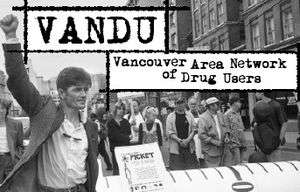Vancouver Area Network of Drug Users

The Vancouver Area Network of Drug Users or VANDU is an advocacy group based in Vancouver, British Columbia, Canada. The group believes that all drug users should have their own rights and freedoms. They have been actively involved in lobbying for support of Insite, Canada's (and North America's) only safe injection site, located in the Downtown Eastside of Vancouver.[2]
Background
Creation
VANDU was created in January, 1998, to combat the many different threats to the social health of the population of drug users living in Vancouver, including overdose.[2] Its founding members include Ann Livingston, and Bud Osborn, who later became a member of the Vancouver-Richmond Health Board.
Notable events
One of the first events held by the members of VANDU, along with the Portland Hotel Society, was to set up 100 crosses in Oppenheimer Park to represent the deaths of drug users due to preventable overdoses.
This placing of crosses was used once again on Parliament Hill to lobby for InSite.
Structure and Goals
Membership
In order to become a member, VANDU asks that a potential member come to sponsored group meetings regularly. Also, they ask that you review their core values and beliefs to ensure that you agree with all of their views. A visit to their office is then required to get on to the members list. The membership is not limited to peoples who have used illicit drugs, but those who have not used do not have a vote.[1][3]
Goals and Beliefs
The following is an except from the VANDU website, outlining their goals and beliefs:
| “ | In keeping with our goals and beliefs, VANDU:
|
” | |
| — VANDU, VANDU Website[4] | |||
In 2009, the acting executive director of VANDU, Ann Livingston, illustrated that the then-recent violence in Vancouver is directly related to drug policy.[5] She argues that, in accordance with the beliefs of VANDU, prohibition should be altered or dropped and a legal drug market be created to eliminate most of the harms associated with drug use.
Staff and Teams
VANDU has created an injection support team to "provide education and support" for users who use intravenously and need education on how to safely inject.[6] This team actually gives direct information to injectors on how to physically inject themselves, as opposed to general harm reduction information, which simply recommends using clean equipment but does not touch the subject of actual injection assistance.
See also
- Harm Reduction
- Prohibition
- Demand reduction
- Safe injection
- Students for Sensible Drug Policy (SSDP)
- Law Enforcement Against Prohibition
References
- 1 2 VANDU Pamphlet Page 1
- 1 2 Vancouver Area Network of Drug Users (2009). "VANDU". Retrieved 2009-04-02.
- ↑ VANDU Pamphlet Page 2
- ↑ "VANDU Website".
- ↑ "24hrs web article".
- ↑ "Stop The Drug War Article". stopthedrugwar.org.
External links
- VANDU - Official website